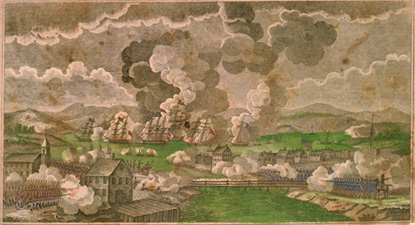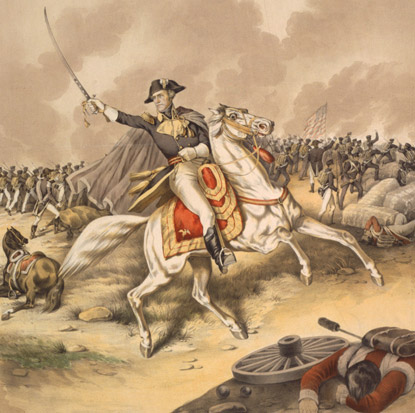The year 1814 decided the war, but with unexpected results. Americans abandoned any thoughts of offensive operations and braced for a wave of British invasions. In Europe, the distraction of Napoleon came to an end in mid-1814 when he was defeated and forced into exile, requiring the United States to face the prospect of thousands of seasoned British veterans becoming available for the war in North America. The British planned accordingly.
News about the victory in New Orleans reached Washington, D.C. in early February 1815, shortly before the treaty of peace arrived from Europe. The two events became linked in the public mind as evidence, if dubious, of America winning the war.
Misfortune Plagues the British

Library of Congress, Prints and Photographs Division
In the summer of 1814, Sir George Prevost moved by land and water out of Canada along the traditional New York invasion route of Lake Champlain. In addition to taking the fight to the United States, the campaign intended to isolate disaffected New England states and possibly persuade them to make a separate peace. The raids in Chesapeake Bay were to prevent American troops from moving north to resist the British advance and to target the homeports of American privateers long the bane of British shipping. After the assault on Washington, the combined British force moved on Baltimore.
And then miraculously for the Americans, everything fell apart for the British. On paper Prevost’s New York invasion looked irresistible and promised a quick path to final victory, but the enterprise rapidly unraveled when the British lost a key battle on both land and water at Plattsburgh on September 11, 1814. Without naval forces to keep his supply lines intact, Prevost could not continue southward. He headed back to Canada. Similarly, the British assault on Baltimore failed when stubborn American militia, including some units that had taken flight at Bladensburg, stood their ground and the bastion of Fort McHenry withstood the Royal Navy’s relentless bombardment, denying passage to the city’s Inner Harbor. By mid-September 1814, the vaunted British offensives in the northern and eastern theaters had ended in failure despite their enormous advantages of greater numbers, more experienced soldiers, and a seemingly irresistible momentum in defeating Napoleon. Everyone was surprised.
Surprising American Resiliency

Library of Congress, Prints and Photographs Division
Yet the greatest surprise of the war was yet to take place. A third British strike of 1814 was aimed at New Orleans on America’s soft underbelly, the coast of the Gulf of Mexico. British success in the gulf would have imperiled the entire Mississippi Valley, and possibly would have altered the outcome of the war, regardless of the battle there occurring after the conclusion of peace negotiations. At New Orleans, Andrew Jackson commanded an ungainly assortment of 7,000 men, including sailors, regulars, buccaneers, and Frenchmen, along with militia from Louisiana, Kentucky, and Tennessee, some of them lacking weapons. Two Louisiana regiments of about 400 free black volunteers were part of the defense as well.
The British, accustomed to militia running like frightened rabbits, derisively called the Americans defending New Orleans “dirty shirts.” Six months earlier, American and British forces had slugged out a bloody stalemate at Lundy’s Lane near Niagara Falls, a battle so costly that all four main commanders under both Stars and Stripes and Union Jack were wounded. But the grudging respect won at Lundy’s Lane was blithely cast aside by the swaggering British outside of New Orleans. After all, the redcoats reasoned, they had some 8,000 seasoned veterans, control of the Mississippi and Lake Borgne, and no less than the Duke of Wellington’s brother-in-law, Lieutenant General Sir Edward Pakenham, at their head. But the Americans did not run, and the British frontal assault on January 8, 1815, dealt them the most crushing defeat of the entire war. More than 2,000 were killed or wounded in half an hour. American casualties numbered fewer than a hundred.
"Victory" Proclaimed
The news about New Orleans reached the capital in early February 1815, shortly before the treaty of peace arrived from Europe, linking the two events in the public mind as proof that the British defeat on the gulf meant the United States had won the war. This was hardly the case, of course. American land campaigns in the War of 1812 were almost all failures. With the exception of Harrison on the Thames River, every assault on Canada miscarried, and except for stalwart behavior at such places as Chippewa, Plattsburgh, Baltimore, and New Orleans, militia and regulars alike rarely covered themselves with glory. A major consequence of the war on land, however, was a discernment that militia alone was insufficient for national defense. After the war, concerted efforts to promote professionalism in the officer corps led to innovations and improvements in the curriculum and organization of the United States Military Academy. And for a time, Americans maintained a larger standing army than had been politically possible before the war. Yet enthusiasm for that policy gradually faded as years passed uneventfully and the country looked westward, the war itself to become, in the words of one historian, “America’s forgotten conflict.”
Part of a series of articles titled Land Operations in the War of 1812 .
Last updated: February 26, 2015
